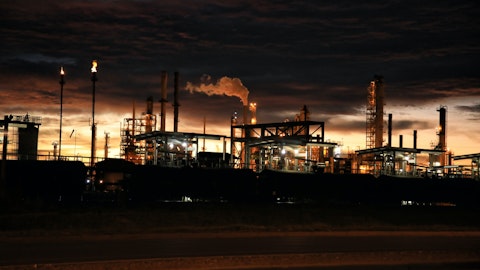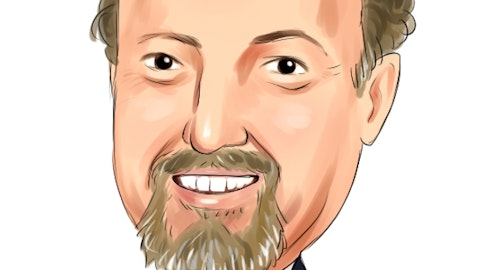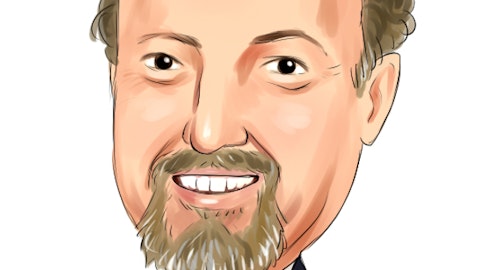Halliburton Company (NYSE:HAL) Q1 2023 Earnings Call Transcript April 25, 2023
Halliburton Company beats earnings expectations. Reported EPS is $0.72, expectations were $0.67.
Operator: Good day, and thank you for standing by. Welcome to the First Quarter 2023 Halliburton Company Earnings Conference Call. Please be advised that today’s conference is being recorded. I would now like to hand the conference over to your speaker today, David Coleman, Senior Director of Investor Relations. Please go ahead.
David Coleman : Hello, and thank you for joining the Halliburton first quarter 2023 conference call. We will make the recording of today’s webcast available on Halliburton’s website after this call. Joining me today are Jeff Miller, Chairman, President and Chief Executive Officer; and Eric Carre, Executive Vice President and Chief Financial Officer. Some of today’s comments may include forward-looking statements reflecting Halliburton’s views about future events. These matters involve risks and uncertainties that could cause our actual results to materially differ from our forward-looking statements. These risks are discussed in Halliburton’s Form 10-K for the year ended December 31, 2022, recent current reports on Form 8-K and other Securities and Exchange Commission filings.
We undertake no obligation to revise or update publicly any forward-looking statements for any reason. Our comments today also include non-GAAP financial measures. Additional details and reconciliation to the most directly comparable GAAP financial measures are included in our first quarter earnings release and in the quarterly results and presentation section of our website. Now I’ll turn the call over to Jeff.
Jeff Miller : Thank you, David, and good morning, everyone. Halliburton’s performance in the first quarter again demonstrated the earnings power of our strategy, strong competitive position and execution for our customers. Here are some highlights from the first quarter. Total company revenue increased 33% compared to the first quarter of 2022 with strong activity in both North America and international markets. Operating income grew 91% year-over-year. Operating margin was 17%, a strong start to the year and 530 basis points over the first quarter of last year. International revenue grew 23% year-over-year with strong activity in all markets. North America revenue grew 44% year-over-year with growth across every basin. The Completion and Production division posted 20% margins, an increase of nearly 700 basis points year-over-year.
The Drilling and Evaluation division grew revenue 17% year-on-year while margins expanded more than 100 basis points. Before we continue, I’d like to recognize the employees of Halliburton for their outstanding execution on every dimension of our business. safety, service quality and financial results. The work you do each day matters to our customers and shareholders. Thank you. I’ll start with a few comments on the macro. Everything I see today validates the strength and duration of this multiyear upcycle. The world requires more energy from all sources, including oil and gas, driven by population growth and economic development. Multiple years of structural underinvestment in oil and gas supply can only be addressed by strong activity over the next several years.
The commodity price volatility experienced in the first quarter does not change our view of customer demand and a tight services market. Our customers around the world recognize this, and we expect their spending to grow in 2023 and beyond. Further, we expect much of this investment will be directed towards development activity, which is great for Halliburton as it drives outsized demand for our products and services. My view of this up cycle is confirmed by what I hear from our customers and see in the world’s oil and gas markets. The Halliburton outlook for both the current year and the long term is strong. Now let’s start with our performance in the international markets. Our revenue in the first quarter grew 23% compared to the same period of last year, reflecting strong activity in all regions.
Halliburton executed its strategy to deliver profitable international growth through leading technology offerings, improved pricing and disciplined capital allocation. I expect international spending to grow high teens for the year 2023, with most new activity coming from the Middle East, Asia and Latin America. I am confident in this outlook because we have a strong pipeline of awards that will commence later this year and beyond. Our completion tool order book grew 40% year-on-year in the first quarter, which generally represents work delivered within the current year. And finally, pricing continues to trend up for all product lines in all regions. I’m excited about all segments of our international business. Today, I’d like to provide more color on our offshore business.
We generated nearly 45% of our international revenue in the first quarter from our offshore business. Here are a few examples of differentiated technologies that drive a higher level of performance, service quality and reliability for our customers. Halliburton’s intelligent drilling and logging while drilling platforms, iCruise and iStar in combination with LOGIX, our automation platform, delivered the longest reservoir section in a single run for a customer offshore Norway. Our latest wireline imaging technology, STRATA Examiner, delivered high resolution, borehole imaging data, allowing a customer to increase reserve estimates during a recent exploration campaign in the Mediterranean Sea. Halliburton’s digital solutions allow our customers to reduce cost per barrel and increase efficiencies.
Hess, Repsol and Petrobras, all recently selected Halliburton Landmark’s DecisionSpace 365 applications powered by iEnergy Cloud. Our trusted science and machine learning algorithms enable customers to optimize subsurface, well construction and production-related decisions. Cognitive Halliburton’s offshore automated cementing system delivers cement jobs remotely with minimal human direction and intervention. More than 30 cement jobs were completed this quarter in the North Sea alone. Finally, I’m excited about the progress of our TechnipFMC alliance on all electric completions. I believe this technology will over time, substantially change the cost and performance of deepwater completions and subsea infrastructure. As I look at 2023 and beyond, I am excited about our international business.
Our customers are clearly motivated to produce more oil and gas. Service capacity is tight and pricing is increasing. Our differentiated technologies and our execution drive margin improvements and growth across our international business. Turning to North America. As I expected, Halliburton achieved strong results despite volatile commodity prices. We delivered on our strategic priority to maximize value in North America through capital efficiency, differentiated technology and alignment with high-quality customers. I know it’s on your minds. So let me briefly discuss the natural gas markets. First, I firmly believe that the gas market softness will be solved the 6 billion cubic feet per day of additional LNG export capacity comes online in the next 24 months.
Second, in response to market conditions, we are moving 3 fleets from gas basins to oil basins to satisfy specific customer demands. Finally, we retired 1 Tier 2 diesel fleet which will reduce our near-term maintenance costs and accelerate Halliburton’s transition to e-fleets. These actions reduced our gas market exposure by about 30% and maintain financial returns. I reiterate my expectation that North America customer spending will grow at least 15% in 2023. At today’s oil prices, I believe that our customers will execute their activity plans and the market for highly efficient equipment and quality services will remain tight. Our strategy is to maximize value in North America. Let me be crystal clear about what that looks like. First, we improved the performance and utilization of our existing fleet and we align with high-quality customers who value our operational efficiency and consistent execution.
Here’s what the customers are telling me. Halliburton’s performance is different, not only better than your competitors, but even better than your own past performance. Our step change in performance, safety and operational efficiency comes from our investments in new technologies, crew training and process improvements. As a result, today, we see a 60% improvement in pumping utilization across our entire North America land fleet since 2019. Second, we only deploy service capacity to attractive return opportunities. We are always finding ways to improve average fleet returns. Finally, we invest in differentiated products and services that improve margins and asset velocity. Our patented Zeus e-fleet and SmartFleet are examples they maximize asset values for our customers and structurally improve returns for Halliburton.

Christian Lagerek/Shutterstock.com
Our Zeus e-fleets continue to outperform for our customers and smart fleet adoption is accelerating. We delivered about 6x more smart fleet stages in the first quarter than a year ago. Halliburton’s position and outlook in North America is strengthened by the uptake and contract duration of our e-fleets. The contracting structure for e-fleets, which we only deploy on multiyear contracts and our technology road map for the future, create structural strength in Halliburton’s North America business. Halliburton’s e-fleet technology is proven to deliver better performance, lower total cost of ownership and increased operating efficiency. For customers with the mandate to produce barrels over the long term, and maximize the value of their investment dollars, the attraction to e-fleets is self-evident.
To summarize, I believe Halliburton is uniquely positioned to deliver financial outperformance, our strong execution culture, differentiated technology portfolio and collaborative approach with customers give us a strong competitive advantage. I am confident that we will execute our strategic priorities and deliver shareholder returns by maximizing value in North America, delivering profitable international growth and driving capital efficiency. Before I turn it over to Eric, I’d like to leave you with 2 financial points. First, given my outlook, I expect the execution of our strategy will deliver significant and growing free cash flow. Second, while our previously announced capital return framework provides a minimum of 50% free cash flow back to shareholders, it also gives us the flexibility to return more cash to shareholders in the form of share buybacks.
Everything I see today points towards more cash to shareholders. Now I’ll turn the call over to Eric to provide more details on our financial results. Eric?
Eric Carre : Thank you, Jeff, and good morning. Let me begin with a summary of our first quarter results. Total company revenue for the quarter was $5.7 billion, a 33% increase over the first quarter of last year while operating income was $977 million, an increase of 91% year-over-year. Operating margin for the company was 17.2% in the first quarter which is an increase of 530 basis points over the first quarter of 2022. These results were primarily driven by increased global activity, improved pricing and strong seasonal product and software sales. Our first quarter reported net income per diluted share was $0.72, which more than doubled from the same period last year. Beginning with our Completion and Production division, revenue in the first quarter was $3.4 billion, a 45% increase when compared to the first quarter of 2022 while operating income was $666 million, an increase of 125% when compared to the first quarter of 2022.
C&P delivered an operating income margin of 20%, driven by increased activity, improved pricing and service efficiency in North America. In our Drilling and Evaluation division, revenue in the first quarter was $2.3 billion, an increase of 17% when compared to the first quarter of 2022, while operating income was $369 million an increase of 26% when compared to the first quarter of 2022. D&E delivered an operating income margins of 16% and driven by strong wireline, testing and drilling-related services globally and an uptick in international activity. Now let’s move on to geographic results. Our first quarter international revenue increased 23% year-over-year due to solid product sales, activity increases and pricing gains across multiple product lines.
In North America, revenue in the first quarter was $2.8 billion, a 44% increase when compared to the first quarter of 2022. This increase was primarily driven by increased stimulation activity and efficiencies, higher activity across our well construction product lines in North America land as well as higher activity across multiple product lines in the Gulf of Mexico. Latin America revenue in the first quarter was $915 million, a 40% increase when compared to the first quarter of 2022 due to increased well construction services and stimulation activity in Mexico and Argentina, and higher completion tool sales across the region. Europe Africa revenue in the first quarter was $662 million, a 2% decrease when compared to the first quarter of 2022 as a result of the sale of our Russian operations, along with decreased activity across multiple product service lines in Norway.
This decrease was partially offset by increased well construction services and stimulation activity throughout Africa. Middle East Asia revenue in the first quarter was $1.3 billion, a 30% increase when compared to the first quarter of 2022 primarily due to improved activity across multiple product service lines in Saudi Arabia, higher completion tool sales, improved well construction services and increased project management activity across the region. Now I’d like to cover some additional financial items. In the first quarter, our corporate and other expenses was $58 million. For the second quarter, we expect our corporate expenses to be up about $5 million. Net interest expense for the quarter was $79 million. For the second quarter, we expect this expense to be about flat.
Other net expense for the quarter was $69 million, primarily related to unfavorable foreign exchange movements. For the second quarter, we expect this expense to decline approximately $15 million. Our effective tax rate for the first quarter came in at approximately 21%. Based on our anticipated geographic earnings mix, we expect our second quarter effective tax rate to increase about 50 basis points. Capital expenditure for the first quarter were $268 million. We anticipate that our remaining capital expenditures will increase quarter-over-quarter into the end of the year and total capital expenditures to be approximately 6% of our revenue for the full year. Our first quarter cash flow from operations was $122 million, and free cash flow was a use of $105 million.
These results were primarily driven by seasonal investments in working capital. As is typical for our business, we anticipate our cash flow will be back-end loaded for the year. We expect to generate strong free cash flow for the rest of 2023. As a step toward achieving Halliburton’s capital return policy of returning at least 50% of annual free cash flow to shareholders, we repurchased approximately $100 million of common stock during the first quarter. Finally, turning to our near-term operational outlook. Let me provide you with some comments on how we see the second quarter unfolding. In our Drilling and Evaluation division, we expect the seasonal revenue decline in software sales to be partially offset by further improvements in global drilling activity.
As a result, we anticipate sequential D&E revenue to increase low to mid-single digits and margins to decline 50 to 100 basis points. In the Completion and Production division, we anticipate sequential revenue to increase low to mid-single digits and margins to improve 25 to 75 basis points. I will now turn the call back to Jeff.
Jeff Miller: Thanks, Eric. Let me summarize our discussion today. Halliburton’s performance in the first quarter demonstrated the earnings power of our strategy. My outlook for Halliburton is strong. I expect international year-on-year growth in the high teens North America growth in excess of 15%. And finally, everything I see today points towards more cash to shareholders. And now let’s open it up for questions.
See also 12 Most Promising Healthcare Stocks and 11 Most Promising Gene Editing Stocks.
Q&A Session
Follow Halliburton Co (NYSE:HAL)
Follow Halliburton Co (NYSE:HAL)
Receive real-time insider trading and news alerts
Operator: Our first question comes from Dave Anderson with Barclays.
Dave Anderson : So let’s just get right into it. Despite the strong numbers you put up in North America this quarter and the guide for second quarter, we kind of firmed up everything. The bear case has been heating up during the quarter with the rig count softening a bit. A&P suggesting pricing is poised to come down. On the other hand, we’re hearing from you, other service companies that you don’t see this slowdown. In fact, prices continue to rise. I wonder if you help kind of help us start up the disconnect here. Does the difference line to customer mix? I know you highlighted the gas market and particularly weak. Is the differentiation of equipment just a lot of rhetoric keep during the quarter. I’m just wondering how we should be thinking about your U.S. land activity and the pricing trends in the second half.
Jeff Miller: Yes. Well, thanks, Dave. Look, prices aren’t moving down. And I think from our comments, I’ve told you what we’ve done and what we plan to do. Overall margin improvement comes from structurally bifurcated market, as you described, demand for high-quality services are very much in demand and hard to deliver. And quite frankly, the cost of the frac hasn’t changed. I mean the engines are moving up. There’s still inherent inflation in the frac business today. So there’s not a connection there. And so as I look out at the rest of the year, we continue to improve the earnings power of our fleet through bifurcation, delivery of these fleets, retirement of — it needs to be retired, be clear, not stacked, but retired. And then finally, efficiency and sort of repositioning around better pricing.
Dave Anderson : But pricing in your mind, continues to move higher. And I would assume that pricing from last year still continue to roll through your fleets?
Jeff Miller: I would say on average. Yes.
Dave Anderson : And if I could just shift gears over on the international side, your Middle East business doesn’t get a ton of credit on the street, despite actually being just as big as kind of 1 of your bigger peers on a relative sense, I was wondering if you could talk about how you see the pace of activity progressing this year in the Middle East. Are you still ramping up on contracts? I think you had kind of alluded to that in your prepared remarks, but what is — also what is your outlook on tenders in the Middle East this year? And I guess, finally, should we expect to see a lift in D&E margins next year based upon what you’re seeing in pricing activity levels this year in the Middle East?
Jeff Miller: Yes. Look, pricing is improving. And so — and I would expect D&E margins to improve along with that. I would still argue early innings of activity increase in the Middle East I’m pleased with our growth. So thank you for pointing that out. But I see this continuing rig counts aren’t necessarily at near peak. And I think we’ve got a lot of opportunity to continue to run. And then broadly, international, it’s beyond the Middle East, pleased with the growth that we saw in the first quarter. And just a reminder to to everyone that in Q1 of ’22, Russia was 2% of our business. And so that’s really pretty strong growth.
Operator: We have a question from Arun Jayaram with JP Morgan.
Arun Jayaram: Jeff, just digesting service prints and outlooks thus far, we are seeing or observing more resilient conditions in U.S. frac versus drilling. I wanted to get your thoughts on why do you think this is the case? And how do you see things playing out in terms of your drilling-related segments at Sperry in North America over the balance of the year?
Jeff Miller: Yes. Look, I think wells drilled in North America really a function of DUC count. So as the DUCs get drawn down, more wells have to be drilled. And so I think fluctuation in drilling. And it’s interesting that you see fluctuation in drilling, but a very steady march in terms of frac. And I think some of that is managing cost at the margin. but the fact is they don’t produce more without fracking wells. And so I’m not surprised to see that. I think our D&E business in North America remains strong. confident on what we’re seeing there. We continue to sort of make gains in the drilling part of the business. And I would say the other service lines are very strong.
Arun Jayaram: Great. Great. And just my follow-up, Jeff, you mentioned that you have some sort of relationship with FTI on the electric side. I was wondering if you could maybe give us some more details on that partnership?
Jeff Miller: Yes. Look, this is an opportunity to mine what the 2 companies really do well. And they’re particularly areas where we overlap, and we’re taking advantage of that. We’ve been working on a series of things and 1 of which is all electric completions for about 5 years is — and we just signed up for another 5 years with TSMC. So great partner in this area. What we’ve delivered ultimately will be, I think, a revolutionary all-electric solution. They really only — it takes the 2 of us to solve for, it’s not the bulk of either 1 of our businesses. But the fact is in this narrow space, we bring some really unique synergies and opportunity to develop technology. And so very pleased with the relationship and the progress that we’re making up to and including we’re jointly marketing and selling some solutions today.
Operator: Our next question comes from James West with Evercore ISI.
James West: So Jeff, I know you spend, guys, probably 60-plus percent of your time on the road seeing customers and a lot of that — the majority of that internationally could you maybe describe the customer conversations at this point where they are with their sense of urgency, where the pushback is, if any, with pricing? Or is there more concern about availability is kind of how we’re thinking about the cycle as it takes off from here. And just curious to hear what you’re hearing on the ground.
Jeff Miller: Yes. Thanks, James. The discussion is more around availability than anything else. Whether it’s services that we provide capital more importantly, availability of tools and people. And a lot of the planning, we’re even doing planning today — I mean, deep planning today for ’24 activity that we expect to ramp up and so there’s enough concern around availability in ’24 that significant resources are committed now to solving for that. So I’ve got a lot of confidence in the runway internationally and the amount of work that we’ve won.





